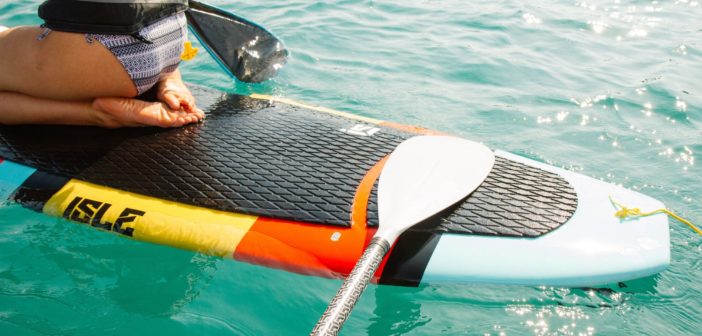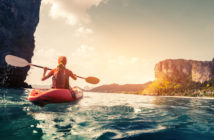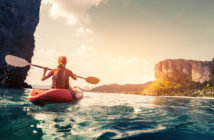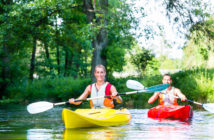Balance is tricky enough for some people to maintain on solid land, but it can be an even bigger issue when learning how to paddleboard! You need good balance to paddleboard. There’s no way around it except to sit on your board and not enjoy the full experience.
But, the good news is that it’s not as hard to find and keep your balance as you might think. Even if you don’t work on your balance much, there are a few simple things you can do to imp rove it while on a paddleboard.
Here are 7 easy tips to use for balance the next time you go paddleboarding!
1. Don’t Stand Up Right Away
A lot of first-time/beginner paddleboarders get overwhelmed when they try to do everything at once. You can’t expect to be able to stand up right away, stay standing, and paddle well, too.
It’s better to get a feel for the board and the water on your knees first, then by standing all the way up. This allows you to experience how steady you should feel when you do stand. More so, it helps you focus on paddling and maintaining your direction, which you’ll need to be able to do once you get your balance under control.
2. Stay Close to the Center of the Board
Whether you’re on your knees or standing all the way up, you need to stay close to the center of the board. Luckily, a lot of paddleboards make it easy for people to figure out where the exact center is.
Some will have outlines where your feet (or knees) should go while others place the handle in the board’s center for you to use as a visual and plant your feet around. Either way, don’t lose this once you find it.
The key to finding your own center is to avoid going too far up or back on the paddleboard. It’s not impossible to stand off-center, but it’s definitely a lot harder.
Also, don’t stand with your feet right next to each other. Keep them at hips distance or a little wider in order to find your balance.
3. Evenly Distribute Your Weight
Once you’re comfortable paddling on your knees, it’s time to work on standing up and staying up. The most important thing to keep in mind is that you have to evenly distribute your weight. This goes for whether you’re kneeling or standing, and it’s especially important as you’re transitioning from one to the other.
To evenly distribute your weight means to stand firmly on both feet without leaning more on one or the other. Most people tend to lean side to side when they stand in line somewhere or when they’re just casually talking to people. But, this doesn’t do anything good for your balance on a paddleboard.
It may take some thinking for you to keep your weight even on each foot. This will start to feel natural after a little while, though.
4. Use Your Core
As important as it is to distribute your weight evenly and put your feet in the center of the board, you have to use your core, too. Your abs are a fundamental component of your balance. The stronger your core is, the easier your balance will be to maintain on a paddleboard or anywhere else for that matter.
It’s a good idea to activate your core a bit before getting on the paddleboard. This makes it a lot easier to use your abs once you’re out on the water. You don’t need to do a full ab workout; a few rounds of situps or planks will do the trick.
5. Create a Slight Bend in Your Knees
Here’s something to think about: your knees. It’s a lot easier to stay steady and keep yourself from wearing out when you create a slight bend in your knees. This standing position is better for your joints and it supports your balance, too.
Plus, you can bend your knees even more if you’re having trouble standing steady. Think of it as a brace if you feel yourself losing your balance.
6. Lean Forward a Bit
Speaking of bracing yourself, try leaning forward a bit with your torso. Be careful of doing this too much as this will put you off-center. But, moving your shoulders slightly forward and your hips a bit backward can make a big difference in your balance.
They help the distribution of your weight and they make it easier to recover if you feel yourself going off balance, too. Leaning forward means you have a little room to lean back when you lose your balance before you go too far back. On the contrary, if you were to stand straight up, the slightest backward movement would make you lose your balance.
7. Pay Attention to the Current
The final way to keep your balance on a paddleboard is to pay attention to your surroundings. Think about it: you could be casually minding your business on a lake or a river then have a boat go by you. The boat creates a current, and the current will feel like your board is going over bumps.
The current tends to be much stronger in ocean water. As such, it’s not the smartest idea to go paddleboarding in the ocean until you’ve gotten the hang of it. The only exception is when you’re in a calm ocean area like a bay or in shallow water, or if you don’t mind falling a few times while you’re learning, of course.
Learning to Paddleboard Made Simple
Bonus tip: the best way to find and keep your balance on a paddleboard is to not overthink it! Use the tips above to help you learn the basics. Once you get a feel for balancing, though, just relax and let yourself enjoy the moment.
Even if you fall a few times, it’s not the end of the world. In fact, it helps you learn and it reminds you that you don’t have to be perfect at everything you do, epsecially on the first couple of tries.
For more paddleboarding insights and pieces of advice, click here.




